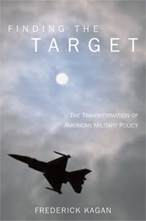|
Reviewed by Mark T. Clark, Ph.D., Professor of Political Science, Director of the National Security Studies program, California State University, San Bernardino, Director of the CSU Intelligence Community Center of Academic Excellence In the realm of public policy, new ideas usually have mere consequences. But in the world of military affairs, the consequences of ideas can be death and destruction.To fully grasp the importance of Frederick Kagan’s Finding the Target: the Transformation of American Military Policy, the reader must understand Kagan’s critique of the post-9/11 wars in Afghanistan and Iraq, which were hailed triumphantly as successes by proponents of the “transformation” of war, and certainly by Bush Administration officials. Kagan, a resident scholar at the American Enterprise Institute, asks tough questions that highlight the many problems that plagued the U.S. in both conflicts. Certainly, the U.S. quickly routed the Taliban in the fall 2001 and the Iraqi army dissolved in the face of very modest U.S. military forces in the spring of 2003. But why, Kagan asks, can such spectacular military conquests lead to such post-conflict disarray, insurgency, and political chaos? Kagan blames the ideas of “transformation” that developed during the 1990s and later espoused by Secretary of Defense Donald Rumsfeld beginning in 2001. Kagan has been a vigorous critic of the Bush Administration in both wars. In essays published elsewhere, he has shown that Rumsfeld’s approach to “transformation” makes military strategy more of a targeting drill than an attempt to impose a leader’s political will on an adversary. Further, the Administration’s approach to Iraq was to topple the regime of Saddam Hussein without giving serious consideration to the political fallout that would occur after the regime’s defeat. Since transformation under Rumsfeld meant the development of smaller, lighter, more mobile military forces, the military strategy in both conflicts simply became quicker defeat of the opponent’s military forces. But, with lighter, less armored forces, protection depends upon tactical preemption of enemy forces—tactics ill-suited to restoring civil order. Only one M-1 Abram’s tank has been lost in the Iraq war, but hundreds of smaller, unarmored vehicles (and thousands of soldiers) have been lost to roadside bombs and rocket-propelled grenades.Kagan’s analysis of the transformation debate starts with the Soviet Union’s development of its nuclear-focused “revolution in military affairs” in the 1960s. While U.S. began thinking military transformation in the aftermath of Vietnam—after confronting the shift to an all volunteer force, stunning failures of airpower, and the increasing Soviet threat in Europe—it wasn’t until the 1980’s did the Soviet-inspired ideas of altering organization and technology come into vogue in pro-transformation circles. Kagan focuses on how these ideas affected Reagan-era defense policy which was the source of the success of the first Gulf War in 1991.In subsequent chapters, Kagan examines the changing debate as it unfolded after the collapse of the Soviet Union which provided a backdrop of no specific threat or set of problems to solve. He convincingly argues that transformation worked best when trying to solve immediate, clearly identified problems like those of the 1970s and 1980s described above. Transformation is least likely to be productive in the absence of clearly understood problems, such as those of the 1990s when U.S. defense planning moved from a “threat-based” force planning model to a “capabilities-based” planning model with attendant problems.Kagan introduces the reader to many old, but some new, terms that an observer of American military affairs and national security policy of these periods would recall. Such terms include “Net-Centric Warfare”, “Force XXI”, the “Objective Force,” and the like. He also introduces readers to some of the key thinkers who influenced the debate for good or ill, including John Boyd, John Warden, and even “futurist” Alvin Toffler, whose ideas probably most heavily influenced the current direction of the debate. Despite his criticisms, Kagan has been credited with influencing the Bush Administration on the idea of the Iraq “surge,” a strategy now showing promise as a solution to some of the problems brought about by the ideas of transformation. Whether one agrees with him on every detail, this work is a must-read for those interested in grappling with the whole transformation debate, and understanding how grand ideas on defense can have large implications in policy, especially as they play out in the War on Terror. |


 Finding the Target: The Transformation of American Military Policy
Finding the Target: The Transformation of American Military Policy